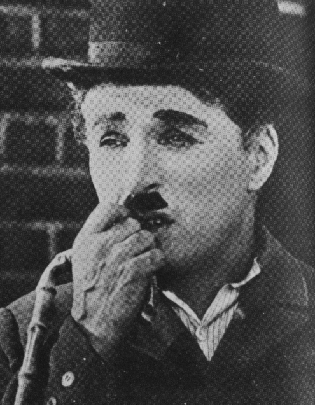
Prepared for Prof. Paige Baty: Political Science 335
Looks Best On Netscape 1.1 or Better. Updated: 12/14/95 (some links fixed)
Send Mail to gerstein@math.ucsb.edu

 For the purpose of this study, I will use the terminology that many film historians have: that Charlie is the filmic alter ego of Charles Chaplin, filmmaker. And Charlie Chaplin, under that name, and under such nom-de-plumes as "the eternal tramp," "the tramp philosopher," and so on, has risen to fame as an icon alone. Unlike the characters played by many actors over the years, Charles Chaplin's Tramp was a consistent character who grew in depth and complexity over the years to become a powerful icon and symbol. While Chaplin himself was, of course, prominent on the world scene as well, he was less the being celebrated, when folk spoke his name, than his icon was: the iconic stature really belonged to his far more prominent filmic creation, for better or worse. Some knew the man and his foibles, but if so, they viewed them through the veneer of Charlie the Tramp: the blessing of the Tramp to cinema excused his creator's iniquities, while on the other hand, the Tramp at times formed a constricting device that manipulated what others expected to find in the man. And of course, at times man and icon spoke as one.
For the purpose of this study, I will use the terminology that many film historians have: that Charlie is the filmic alter ego of Charles Chaplin, filmmaker. And Charlie Chaplin, under that name, and under such nom-de-plumes as "the eternal tramp," "the tramp philosopher," and so on, has risen to fame as an icon alone. Unlike the characters played by many actors over the years, Charles Chaplin's Tramp was a consistent character who grew in depth and complexity over the years to become a powerful icon and symbol. While Chaplin himself was, of course, prominent on the world scene as well, he was less the being celebrated, when folk spoke his name, than his icon was: the iconic stature really belonged to his far more prominent filmic creation, for better or worse. Some knew the man and his foibles, but if so, they viewed them through the veneer of Charlie the Tramp: the blessing of the Tramp to cinema excused his creator's iniquities, while on the other hand, the Tramp at times formed a constricting device that manipulated what others expected to find in the man. And of course, at times man and icon spoke as one.The current study, supplemented on the Web by much of its source material and a wide variety of illustrations, will look in depth at how Chaplin developed the Tramp as an icon and how the public responded at first; I will then follow by analyzing how Chaplin and Charlie the Tramp agreed and differed on six various aspects of life. I will look at how theorists, philosophers, and audiences viewed both Chaplin and Charlie in the reflection of the other; how the man attempted to use the icon to his advantage, sometimes succeeded, and sometimes failed. (Since the Tramp -- and Chaplin's major promotion of that character as an icon -- does not cover the final period of Chaplin's career, later incidents will only be discussed when necessary. Similarly, occasional non-Tramp films produced in the "golden age" are outside the current discussion as well.)
This should be an interesting exploration, and to make things easier, I have broken my study into seven constituent essays (not including this introduction). The menu below will let you access them as well as much of the source material I used.

Chaplin Life Chronology, based on original version by Wes D. Gehring.
My Chaplin Text Resources: Quick links to the textual resources you can also access through my essays.
My Chaplin Gallery, all the pictures from my essays plus a good many additional illustrative references. You haven't seen my Chaplin pages until you've seen this collection!
My Bibliography, a list of the books I used to do this project.


Go to David Gerstein's Virtual Inkwell